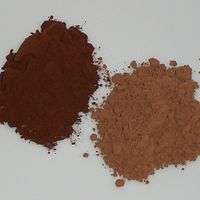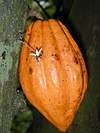Cocoa solids
Dry cocoa solids are the components of cocoa beans remaining after cocoa butter, the fat component, is extracted from chocolate liquor, roasted cocoa beans that have been ground into a liquid state. Cocoa butter is 50% to 57% of the weight of cocoa beans and gives chocolate its characteristic melting properties. Cocoa powder is the powdered form of the solids sold as an end product.

Cocoa powder contains flavanol antioxidants, amounts of which are reduced if the cocoa is subjected to acid-reducing alkalization.[1] Health benefits have been attributed to cocoa flavonoids.[2]
Physical properties

Natural cocoa powder has a light-brown color and an extractable pH of 5.3 to 5.8.[1] The processed (alkalized) cocoa powder is darker in color, ranging from brownish red to nearly black, with a pH of 6.8 to 8.1. The alkalization process reduces bitterness and improves solubility, which is important for beverage product applications. All of these pH values are considered safe for food use.[3]
Nutrition
| Nutritional value per 100 g (3.5 oz) | |
|---|---|
| Energy | 954 kJ (228 kcal) |
57.90 g | |
13.70 g | |
19.60 g | |
| Minerals | Quantity %DV† |
| Calcium | 13% 128 mg |
| Iron | 107% 13.86 mg |
| Magnesium | 141% 499 mg |
| Manganese | 183% 3.837 mg |
| Phosphorus | 105% 734 mg |
| Potassium | 32% 1524 mg |
| Sodium | 1% 21 mg |
| Zinc | 72% 6.81 mg |
| Other constituents | Quantity |
| Water | 3.00 g |
| Caffeine | 230 mg |
| |
| †Percentages are roughly approximated using US recommendations for adults. Source: USDA Nutrient Database | |
Cocoa powder contains several minerals, including calcium, copper, magnesium, phosphorus, potassium, sodium, and zinc. All these minerals are found in greater quantities in cocoa powder than either cocoa butter or chocolate liquor.[2] Cocoa powder also contains 230 mg of caffeine and 2057 mg of theobromine per 100g, which are mostly absent from the other components of the cocoa bean.[4] Cocoa powder also contains clovamide (N-caffeoyl-L-DOPA).[5][6]
Flavonoids
Cocoa powder is rich in flavonoids, a subset of polyphenols. The amount of flavonoids depends on the amount of processing and manufacturing the cocoa powder undergoes.[2] Alkalization, also known as Dutch processing, causes its content of flavonoids to be substantially reduced.[1][7][8]
Safety
Cadmium content
Cocoa powders may contain cadmium, a toxic heavy metal and probable carcinogen, found naturally in high levels in the soil of some regions of cocoa-producing countries. The European Union has imposed a limit (as of 1 January 2019) for cadmium in cocoa powder of 0.6 µg per gram of cocoa powder and 0.8 µg per gram for chocolate with ≥ 50% total dry cocoa solids.[9] In Canada, a daily serving of a natural health product must contain no more than 6 µg of cadmium for an individual weighing 150 pounds (68 kg) and 3 µg for a 75 lb (34 kg) individual.[10] While the US government has not set a limit for cadmium in foods or health products, the state of California has established a maximum allowable daily level of oral cadmium exposure of 4.1 µg and requires products containing more than this amount per daily serving to bear a warning on the label.[11] One investigation by an independent consumer testing laboratory found that seven of nine commercially available cocoa powders and nibs selected for testing contained more than 0.3 µg of cadmium per serving gram; five of these products exceeded the proposed EU limit of 0.6 µg per gram.[7]
See also
References
- Miller, Kenneth B.; Jeffery Hurst, William; Payne, Mark J.; Stuart, David A.; Apgar, Joan; Sweigart, Daniel S.; Ou, Boxin (2008). "Impact of Alkalization on the Antioxidant and Flavanol Content of Commercial Cocoa Powders". Journal of Agricultural and Food Chemistry. 56 (18): 8527–8533. doi:10.1021/jf801670p. PMID 18710243.
- Steinberg, F. M.; Bearden, M. N.; Keen, C. L. (2003). "Cocoa and chocolate flavonoids: Implications for cardiovascular health". Journal of the American Dietetic Association. 103 (2): 215–223. doi:10.1053/jada.2003.50028. PMID 12589329.
- Materials Handled Cocoa Powder: Overview Archived 2014-04-07 at the Wayback Machine. Retrieved: 2 April 2014.
- "USDA National Nutrient Database for Standard Reference, Release 24, (2011)".
- Sanbongi, Chiaki; Osakabe, Naomi; Natsume, Midori; Takizawa, Toshio; Gomi, Shuichi; Osawa, Toshihiko (1998). "Antioxidative Polyphenols Isolated from Theobroma cacao". Journal of Agricultural and Food Chemistry. 46 (2): 454–457. doi:10.1021/jf970575o. PMID 10554262.
- Arlorio, Marco; Locatelli, Monica; Travaglia, Fabiano; Coïsson, Jean-Daniel; Del Grosso, Erika; Minassi, Alberto (2008). "Roasting impact on the contents of clovamide (N-caffeoyl-L-DOPA) and the antioxidant activity of cocoa beans (Theobroma cacao L.)". Food Chemistry. 106 (3): 967–975. doi:10.1016/j.foodchem.2007.07.009.
- "Product Review: Cocoa Powders, Dark Chocolate, Extracts, Nibs, & Supplements". ConsumerLab.com. ConsumerLab.com LLC. 17 May 2014. Retrieved 10 February 2015.
- "Chocolate Terms". Thenibble.com. Retrieved 2013-05-27.
- "Commission Regulation (EU) No 488/2014 of 12 May 2014: Amending Regulation (EC) No 1881/2006 as regards maximum levels of cadmium in foodstuffs". 2014-05-12. Retrieved 22 August 2016.
- "Quality of natural health products guide". Retrieved 22 August 2016.
- "Proposition 65 Maximum Allowable Daily Level (MADL) for Reproductive Toxicity for Cadmium (Oral Route)" (PDF). Retrieved 22 August 2016.
External links
- Hamel, PJ (10 January 2014). "The A-B-C's of cocoa". Flourish. King Arthur Flour. Retrieved 30 May 2015.
| Wikimedia Commons has media related to Cocoa powder. |
